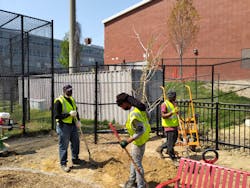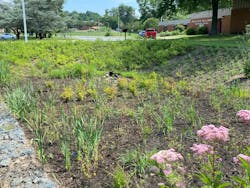Pairing Green Infrastructure with Community Support
Governments sometimes have difficulty developing a MS4 Stormwater Management Plan that is efficient in both time and cost. Likewise, it can be challenging to develop a local workforce to maintain green infrastructure BMPs for the distant future, or to use innovative solutions under a constrained timeline.
One Maryland county’s approach, however, found a way to check every box with astounding success. The county’s partnership finished its first phase of BMPs under budget and in half the time. The program was so successful, in fact, it kickstarted the national trend in Community-Based Public Private Partnerships (CBP3s).
A Big Challenge
Prince George’s County is the second most populated county in Maryland — with 27 towns and cities, more than 909,000 citizens, and over 40,000 acres of developed, impervious land. With Chesapeake Bay Total Maximum Daily Loads (TMDLs) and strenuous MS4 permit requirements, the County faced an enormous challenge in developing its Stormwater Management Plan.
In 2012, Prince George’s County discovered that its fourth-generation MS4 permit would require the County to meet the Chesapeake Bay TMDL requirements. The MS4 permit, to be released in 2014, would also require a list of other tasks to be accomplished by the end of the permit cycle: The County had to lower its pollutants to meet local TMDLs, reduce its impervious surfaces for each cycle, develop a geographic information system mapping for watersheds in the County, and develop public outreach and education programs.
It seemed that the County would face an incredibly difficult task to meet the cost or timeline of its new MS4 and TMDL requirements.
The County decided it would enhance its traditional processes to implement BMPs more quickly and would adopt a CBP3 to treat the 6,105 acres of impervious areas. This CBP3 would become the first in the nation — and would be named the Clean Water Partnership.
The Partnership Model
Public agencies traditionally use a public-private partnership (P3) model to leverage the experience or resources of the private sector for improvements in the public sector. The Clean Water Partnership was the County’s very first private partnership to be used for stormwater management.
P3 models are usually a long-term contract between a private entity and a public agency for key services like the planning, construction, or maintenance of public infrastructure. Within this typical P3, the private entity holds the most responsibilities and risk, while the public agency oversees the project and pays the private entity according to services successfully provided.
The P3 model can accelerate the implementation of stormwater management BMPs by moving beyond the traditional successive design-bid-build process. Instead, the private partner can integrate planning, design and construction into a single free-flowing program that the public sector then monitors.
The Environmental Protection Agency (EPA) developed the CBP3 approach to enhance the benefits of the traditional P3 approach. The CBP3 would provide a framework that maximizes the partnership’s benefit to local workers and small and minority-owned businesses. It was envisioned to reduce the cost of retrofits, reduce their implementation timeframe, promote innovative technologies and reduce the County’s financial and legal risks, just like the P3, but while also maximizing community benefits.
The stormwater CBP3 could maximize community benefits through its focus on green infrastructure and enhanced local development. Green infrastructure (GI) already offers countless co-benefits for communities: beautification, easy integration, sheltering wildlife, etc. Because GI is so decentralized, it can also be easily placed to benefit disadvantaged communities that often suffer the most from insufficient infrastructure and its consequences. With requirements to train and hire a local workforce, the CBP3 ensures that the community enjoys a large share of the economic investment of new infrastructure.
Prince George’s County had often held community-based outcome requirements in its previous partnerships, said Jim Lyons, program manager of the CWP.
“The funds are from the people of the community,” said Lyons, “and they need to benefit the community in more ways than ‘Oh, let’s just fix this; do that.’”
The County issued a Request for Qualifications to select its CBP3 partner. The County hired the engineering firm AECOM to help write the request and to develop an evaluation framework for selecting a partner.
The County had a strong idea for what type of experience they wanted from an applicant.
“How they perform those community-based aspects,” said Lyons, “really drives how the contracts were derived.”
The applicant that would be selected was Corvias Group LLC. Corvias is a property development, construction, and management company that had a national portfolio of P3s with the Department of Defense and with higher education institutions. The County ultimately selected the company for its flexibility, adaptive management style and nearby establishment in Fort Meade, Md.
With a partnership model and candidate chosen, the Clean Water Partnership was launched in 2015.
The Clean Water Partnership is composed of two agreements between Prince George’s County and Corvias: a Master Program Agreement (MPA) and a Master Maintenance Agreement (MMA). The MPA outlined Corvias’s implementation of green infrastructure BMPs for the next three years, and the MMA detailed Corvias’s maintenance of these BMPs for the next 30 years.
The agreements described Corvias’s compensation structure, which included base and performance-based payments for BMP implementation and an incentive fee for meeting the County’s socioeconomic goals.
The agreements included a requirement that at least 40 percent of the work be subcontracted to certified local businesses under the Local, Small, Minority, Women, Veteran and Disadvantaged Business Enterprise (LSMWVBE) certification.
The local workforce wasn’t sufficiently developed for BMP maintenance, according to Lyons. “So the partnership had to stand up a program that specifically built the capacity of these business and created a market so that we had enough businesses doing the work that were based in this county,” said Lyons. “Even our maintenance contracts have that same sort of requirement in them.”
The CWP even provides an analytics portal on its website to track the local business and target class participation, alongside pollutant load reductions and program expenditures.
The MPA also required the implementation of social and economic development programs: the Community Outreach Program to inform and obtain input from County residents during all development phases; the Small Business Outreach and Inclusion Program to promote local businesses’ participation through training and informative sessions; the Mentor-Protégé Development Program to train and enhance the skills of the local workforce for the CWP’s projects; and the Workforce Development Program to promote a future skilled workforce through the County’s education institutions.
“The projects are great — we have a goal and we have to deliver on getting that work done,” said Keisha Brown, partnership liaison for Corvias, “but the connectivity and the community impact is what makes a lot of the difference for why I’m invested in this work.”
Developing the Workforce
One business benefitting from the CWP’s community-based programs is TCG Property Care, a landscaping business based in Ward 7 of Washington, D.C. Ward 7 has been a historically underserved area of the District and shares a border with Prince George’s County.
In 2017, TCG Property Care was founded by Wade Cassamajor, Krystal Talley and Samuel Augustine to help the local community’s unemployment issues through traditional landscaping services.
“I wanted to start a company that would enable us to hire people locally to do work,” said Cassamajor, “I figured a lot of the guys or gals in our community with very little experience could come in, we could hire them, and they could work for us. And the biggest component for us was trying to get contracts.”
“We ended up bidding on the project — and we won. We’ve never looked back since,” said Cassamajor, “because it turned out to be an excellent niche for us to provide our services for.” TCG Property Care would quickly enroll in the CWP’s Mentor Protégé program in 2019 to further commit to green infrastructure services.
The CWP launched the program in 2016 and started it in 2017. Through the Mentor Protégé program, Corvias would train and assist the local workforce in business planning, staffing, purchasing and marketing. Enrolled protégés would also have the invaluable opportunity to network with the more experienced mentor participants.
To date, 39 small businesses have passed through the Mentor Protégé program, which is ready to kick off its fifth cohort.
In early 2020, TCG Property Care also entered CWP's Emerging Landscapers program, which involved similar skill development support for more specific, landscaping-related BMPs. The CWP launched the Emerging Landscapers program to expand the pool of qualified landscaping businesses in maintaining and installing green infrastructure BMPs.
TCG Property Care finished both programs near the end of 2020. Participation for the business was composed of monthly classes and coursework, several opportunities to bid on upcoming projects, and assistance and oversight in the execution of bids. Each of the three owners participated throughout the programs; at least one would attend each monthly class.
“The biggest way the program assisted us was with pairing us with general contractors that were part of the program,” said Cassamajor. “These mentors — they would have projects, they would set them out to bid and, because we were in the program, we had an opportunity to bid on these projects first. So, we sort of had a first crack at it.”
Another major impact of the course for Cassamajor was feedback in both estimating and performing contracted work.
“As a small business,” said Cassamajor, “generally you’re pretty insecure about your figures. You want to be competitive, but you also don’t want to sell yourself short because you want your company to grow. So, getting feedback from other estimators and general contractors was extremely helpful.”
TCG Property Care won several successful green infrastructure installation and maintenance bids, thanks to their participation in CWP’s business development programs.
“This is something that’s contemplated for years and years and years. Our focus is not on the short-term,” said Jim Lyons. “It’s about the business development; it’s about capacity building; it’s about bringing a company in.”
Keisha Brown emphasized the importance of the program’s benefits beyond even the county community level. “They don’t go through the year-long program and walk away; they remain connected,” said Brown. “They’re expanding their business across the county, across the state. We’re able to tell their stories in the region through the other programs that we have.”
Lyons agreed: “We want to make sure that they’re successful with bidding, not just with the county business," said Lyons. "We want them to be located in the county, but we want them to be able to compete for work all across the country, wherever they want to go.”
In addition to the success of the CWP’s community initiatives, the partnership announced in early 2019 that it completed its initial pilot phase in half the time and under budget.
Corvias has also seen an expansion of its stormwater partnerships. The company has entered partnerships through the Great lakes Protection Fund Grant, The Stormwater Authority of Chester, the Fresh Coast Protection Partnership and the Slauson Connect Clean Water Partnership.
“Everyone in this county has been touched, or has visibility of, a clean water partnership stormwater management retrofit or project in their community — directly or indirectly,” said Brown.
So far, the CWP has completed about 136 projects that encompass about 350 sites and BMPs, and has about 400 additional installations in planning. An up-to-date listing of all project statuses, and their locations, is available at the CWP’s website.
“It’s been actually really smooth the entire time, considering how new and how large [the program is]. Nobody’s ever done this type of partnership before,” said Lyons.
The CWP’s success led the EPA to promote the innovative program nationwide. Already, several communities have adopted a CBP3 model for stormwater infrastructure retrofits, and it’s likely many more will adopt this model in the future. SW
Jeremy Wolfe is assistant editor of Stormwater Magazine.
Published in Stormwater magazine, August 2021.
Jeremy Wolfe | Editor, Stormwater Solutions
Jeremy Wolfe is a former Editor for Stormwater Solutions.










